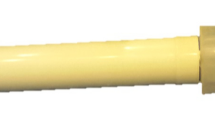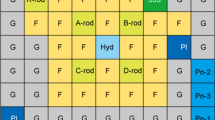Abstract
The assumption that the shape of the epithermal neutron spectrum can be described, in any research reactor, by the 1/E 1+α function is a fundamental starting point of the k 0 standardization. This assumption may be questioned from a reactor physics viewpoint. The type of moderator, the existence of neutron reflectors, the additional production of (γ, n) neutrons and resonance capture by construction materials may be different for each reactor, with consequences for the shape of the neutron spectrum. This dependency may explain that various practitioners reported contradicting experiences with the use of Zr–Au flux monitors for the determination of the α-parameter. An objective view on the influence of the design of the reactor and irradiation facility on the shape of the neutron spectrum can be obtained by modeling. This has been applied in the Reactor Institute Delft for reactor configurations in which the irradiation facilities face the fuel elements with the presence of beryllium reflector elements. The Monte Carlo calculations indicate a distortion of the 1/E 1+α relationship at the higher energy edge of the epithermal neutron spectrum. This distortion is attributed to the formation and thermalisation of both photoneutrons and (n, 2n) produced fast neutrons in the beryllium, and has a direct impact on the resonance activation of 95Zr, other than represented by the 1/E 1+α function. The obtained relationship between neutron flux and neutron energy was also used for estimating the f-value and compared with the value obtained by the Delft Cr–Mo–Au flux monitor.
Similar content being viewed by others
Avoid common mistakes on your manuscript.
Introduction
Girardi et al. [1] introduced the single comparator method for neutron activation analysis (NAA) in 1965. With this method it became possible to automate the analysis to a large extent and to perform multi element analysis at the same time. The values of the experimentally determined k-factors in this method depend on the full energy photopeak efficiency and the irradiation conditions. As such they are specific for the detector and counting geometry, and the irradiation facility and remain valid as long as the neutron energy distribution in the irradiation facility does not change significantly. De Corte and Simonits redefined the measurement equation in the single comparator method in such a way that the k-factors became independent of the neutron energy distribution and counting geometry. To this end, they introduced the neutron spectrum parameters f and α in the measurement equation of their k 0-method as well as the full energy photopeak efficiency parameter ε.
De Corte et al. [2, 3] suggested in 1979 the bare triple comparator method as an alternative for the Cd-covered method to measure the neutron spectrum parameters f and α for in k 0-NAA. It was shown in 1981 that the bare triple method using 197Au–96Zr–94Zr provides acceptable accuracy for most analytical cases in INAA.
Bode et al. [4] reported in 1992 about large variations in the determination of f and α between individual irradiations. The values of some of these f and α values were difficult to explain on basis of the physics and operation of a nuclear research reactor. As an example, two irradiations of five Zr–Au sets carried out within a few months interval without changing the reactor core configuration resulted in f values of 50–63 and 64–90 and α values of 0.07–0.11 and 0.02–0.08, respectively. Similar inconsistent results for f and α estimation by the bare triple monitor were reported by others [5–7].
At the MTAA-11 conference in 2004 Koster-Ammerlaan et al. introduced the Cr–Mo–Au monitor as an alternative for the bare triple monitor [8]. This monitor results also in smaller uncertainties for f and α under the same statistical conditions. The monitor has been used in Delft during the past 3 years to measure f and α after each rearrangement of the fuel elements but without changing the core configuration in number and positioning of the fuel—and reflector elements. The measurements resulted in f values ranging 60–64 and α values of 0.08–0.09 [9].
The Cr–Mo–Au monitor has proven to give consistent result for practical applications in routine INAA. It is, however, still unsatisfactory that the large variations in f and α resulting from the use of the Zr–Au monitor cannot be explained on basis of the physics of NAA.
Several authors indicate the direction of possible explanations. De Corte et al. [3] cast doubt on the validity, for every reactor (type) of the original assumption that the neutron energy dependency of the cross section in the epithermal region can be described by the 1/E 1+α relation.
Brockman et al. [10] describe the hardening of the neutron spectrum due to the 6Li-build up in the Be-reflector elements. The hardening of the spectrum due to the 6Li build up does not explain yet the large variations in f and α between successive irradiations reported by Bode et al.
Beryllium indeed has an impact to the energy distribution of the neutrons on the outside of the reactor core—the position of the irradiation facilities used for NAA. Both epithermal photoneutrons (9Be (γ, n) 2 4He, cross section 0.8 mb) and fast neutrons (9Be (n, 2n) 2 4He, cross section 580 mb) are produced in the beryllium. These neutrons will be moderated and will result in contributions to the normal epithermal spectrum of the uranium fission. It cannot be excluded that these photoneutrons and fast neutrons produced in beryllium have an impact on the shape of the neutron spectrum, with consequences for the 1/E 1+α model used in k 0-NAA. The extent of this has been studied using MCNP modeling of the neutron spectrum in the irradiation facilities of the Delft Hoger Onderwijs Reactor (HOR) used for INAA.
Experimental
The neutron energy distributions of the in-core irradiation facilities were calculated by modeling the reactor core (Fig. 1) and its facilities using MCNP. The simulations were performed using MCNP version 1.51 and the ENDF7 database as supplied with in-house addition of 9Be (γ, n) data for photon neutrons via NJOY processing, running 20,000 cycles of 105 source neutrons each. The facilities, including high purity quartz vials and their location with respect to the core were precisely modeled. The uncertainty of the modeling varies from 1% in the thermal neutron range of the spectrum, to approximately 5% in the epithermal range and 10% in the fast neutron energy range.
The results of the modeling have been verified by NAA of Cr–Mo–Au monitors.
Results and discussion
The neutron flux and the neutron spectrum parameters f and α determined by modeling and measurement were in very good agreement, as already presented in the 5th k 0-users workshop [11] (Belo Horizonte, Brazil, 13–17 September 2009). The output of the modeling is shown in Fig. 2. The energy of the neutrons is plotted as a function of lethargy. In the lethargy presentation the 1/E-relationship changes into a horizontal line and the deviations described by α can be schematically represented as shown in Fig. 3.
The output of the modeling in the epithermal range of the spectrum is shown in more detail in Fig. 4. As can be seen from this figure the 1/E 1+α model is valid for epithermal neutrons up to 10 keV and both the in core as well as the reflector irradiation facility tends to have a negative α-value. In the energy range of 10–100 keV, however, the modeled spectrum is clearly deviating from this model. Radionuclides 99Mo and 198Au have their resonance energies in the epithermal range up to 10 keV where the 1/E 1+α model is in good agreement with the modeled spectra, 95Zr, however, has its resonance energies mainly the epithermal part of the spectrum above 10 keV. Small variations in the production of Be-neutrons may have effects on the activation of 95Zr and therefore the determination of f and α.
It may be obvious that the degree of distortion of the neutron energy distribution in the epithermal range depends on the reactor core configuration, the amount of beryllium surrounding the fuel elements and the moderators used. In the irradiation facilities of the HOR in Delft, used for this experiment the difference in the value of α determined by either the Zr–Au or the Cr–Mo–Ay monitor may end in differences up to 5% in Mo-concentrations.
Conclusions
The results from the calculations and experiments indicate that neutrons produced in Be reflector material may perturb the neutron spectrum in the epithermal range to such an extent that the applicability of the 1/E 1+α model in k 0-NAA may render a significant bias in the NAA results. This phenomenon may also explain the differences of the k 0 values of 95,97Zr (and the related cross sections) determined in different reactors.
It is recommended to evaluate the perturbation of the 1/E 1+α range by the Be epithermal and fast neutron production in different reactor types (e.g., light water + Be reflector, TRIGA, SLOWPOKE/MNSR) to fully understand the neutron energy distribution and its impact to the currently universal model used for describing this distribution. The use of MCNP will be indispensable for this. It sets, however, high demands to the precise detailing of the input model used in these calculations. However, Peters et al. [12] and Ammerlaan et al. [11] have already shown that a high degree of precision can be obtained.
References
Girardi F, Giampaolo G, Pauly J (1965) Anal Chem 37(9):1085–1092
De Corte F, Moens L, Simonits A, De Wispelaere A, Hoste J (1979) J Radioanal Nucl Chem 52:295–304
De Corte F, Sordo-El Hammami K, Moens L, Simonits A, De Wispelaere A, Hoste J (1981) J Radioanal Nucl Chem 62:209
Bode P, Blaauw M, Obrusník I (1992) J Radioanal Nucl Chem 157(2):301–312
De Corte F (2003) Czechoslov J Phys 53(Suppl A):257–263
De Wispelaere A, De Corte F (2003) J Radioanal Nucl Chem 257(3):519–523
Vermaercke P, Robouch P, Sneyers L, De Corte F (2008) J Radioanal Nucl Chem 276(1):235–241
Koster-Ammerlaan MJJ, Bacchi MA, Bode P (2004) In: Spyrou NM, Perry SJ (eds) Book of abstracts. 11th international conference modern trends in activation analysis. Guildford, United Kingdom, 20–25 June 2004, p 100
Koster-Ammerlaan MJJ, Bacchi MA, Bode P, De Nadai Fernandes EA (2008) Appl Radiat Isot 66:1964–1969
Brockman JD, Peters NJ, Robertson JD (2009) J Radioanal Nucl Chem 282:41–44
Koster-Ammerlaan MJJ, Bode P, Kaaijk CNJ, de Leege P (2009) In: Menezes MÂBC (ed) Book of abstracts. International k 0-users workshop. Belo Horizonte, Brazil, 13–17 Sept 2009, p 52
Peters NJ, Brockman JD, Robertson JD (2011) Book of abstracts. MTAA-13. College Station, USA, p 32
Open Access
This article is distributed under the terms of the Creative Commons Attribution Noncommercial License which permits any noncommercial use, distribution, and reproduction in any medium, provided the original author(s) and source are credited.
Author information
Authors and Affiliations
Corresponding author
Rights and permissions
Open Access This is an open access article distributed under the terms of the Creative Commons Attribution Noncommercial License (https://creativecommons.org/licenses/by-nc/2.0), which permits any noncommercial use, distribution, and reproduction in any medium, provided the original author(s) and source are credited.
About this article
Cite this article
Koster-Ammerlaan, M.J.J., Bode, P. & Winkelman, A.J.M. Photoneutrons from a beryllium reflector: a potential source of problems with Zr–Au flux monitors in k 0 standardization based neutron activation analysis. J Radioanal Nucl Chem 291, 569–572 (2012). https://doi.org/10.1007/s10967-011-1241-5
Received:
Published:
Issue Date:
DOI: https://doi.org/10.1007/s10967-011-1241-5








